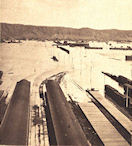Search the Blog
Categories
- Books & Reading
- Broadband Buzz
- Census
- Education & Training
- General
- Grants
- Information Resources
- Library Management
- Nebraska Center for the Book
- Nebraska Memories
- Now hiring @ your library
- Preservation
- Pretty Sweet Tech
- Programming
- Public Library Boards of Trustees
- Public Relations
- Talking Book & Braille Service (TBBS)
- Technology
- Uncategorized
- What's Up Doc / Govdocs
- Youth Services
Archives
Subscribe
Category Archives: Information Resources
Nebraska Blue Book 2010-2011 available
The 2010-2011 Nebraska Blue Book has been published. Each public, academic and state institutional library in Nebraska will be receiving a free copy. It is also available online at http://nebraskalegislature.gov/about/blue-book.php .
The Blue Book is Nebraska’s official reference manual, and is a gold mine of information about the state’s government, geography, economy, history and culture.
Bound, printed copies of the 2010-11 Nebraska Blue Book are available for purchase through the Clerk of the Legislature’s Office and may be ordered by calling (402) 471-2271. The cost is $15 plus postage and sales tax as applicable.
Local Level Data for Nebraska Released
The U.S. Census Bureau today released new, detailed demographic information from the 2010 Census for Alaska, Colorado, Connecticut, Nebraska and North Carolina.
Tables are available for states, counties, county subdivisions, places, census tracts, ZIP code tabulation areas, congressional districts for the 111th Congress and, where applicable, American Indian and Alaska Native areas and Hawaiian home lands. For most subjects, statistics for census block groups and blocks are also shown.
The Summary File 1 tables can be found on the Census Bureau’s American FactFinder website at <http://factfinder2.census.gov/>. A good place to start is the quick tables (noted as “QT” in the search results list), which show a summary of a particular topic for one geographic area at a time. The geographic comparison tables (noted as “GCT”) are a good place to start for a first look at a topic across geographies, such as all places within a state.
Click here to read the full press release.
The Flood of 1881
The Missouri river has flooded many times in recorded history. Floods levels this year may exceed even the record flood of 1952. Although floodwaters were not that high in the flood of 1881, significant damage was done and lives were lost. These two photos show floodwaters inundating the lumber yard and Union Pacific rail yard in Omaha in April 1881.
According to this article on the Nebraska Department of Natural Resources web site:
“The release of water, which was yellow with clay and debris from cornfields, trees, and houses, later flooded Omaha up to 9th Street. Several hundred yards of rip-rap “gave away like cheesecloth” before the floodwaters as they inundated the Union Pacific coal and lumber yards. The River reportedly remained high for several weeks and, during the height of flooding, was reported to have been five miles wide.”
This article from the April 11th 1881 Omaha Daily Bee Slowly Subsiding: The Demon of the Big Muddy Appeased records eyewitness accounts the morning of April 9th:
“At one o’clock this morning the water was rising gradually in the river and pouring into the basins surrounding the lumber and coal yards in overwhelming streams. The main current of the river seemed to diverge somewhat off its course ‘of the day before and to bear away toward the east shore. This was indicated by the action of the ice, which had heretofore pressed with dangerous force against the smelting works and government rip rap. The proprietors of the various lumber yards , the Chicago , Foster Gray and Hoagland , were on hand all night with gangs of men , endeavoring to construct booms around their yards … At six o’clock in the morning , the gauge showed an additional rise of nine inches above the measurement taken at twelve o’clock, making the total height above low water mark nearly twenty-three feet. By this time all of the lumber yards were filling rapidly ; the car shops and engine house belonging to the U. P. works were entirely surrounded and the aspect of affairs were most discouraging. Then , for some unexplained reason , the rise seemed to cease and it was hoped that the flood bad reached its limit. This condition of affairs continued for three hours , and the most active efforts were made to protect the pro0perty of the U. P. company , the smelting works and the lumber yards. At nine o’clock a rush came , and the side tracks which had up to that time acted as barriers to the progress of the flood began to show signs of weakness , and in a few minutes huge parts of the embankments had given away and the water was pouring into the last and remaining basins west of the smelting work . “
Click here to see more images in Nebraska Memories of the flood of 1881 in Omaha.
For more information about this year’s flooding visit this page on NebraskAccess.
Visit Nebraska Memories to search for or browse through many more historical images digitized from photographs, negatives, postcards, maps, lantern slides, books and other materials.
Nebraska Memories is a cooperative project to digitize Nebraska-related historical and cultural heritage materials and make them available to researchers of all ages via the Internet. Nebraska Memories is brought to you by the Nebraska Library Commission. If your institution is interested in participating in Nebraska Memories, see http://nlc.nebraska.gov/nebraskamemories/participation.aspx for more information, or contact Beth Goble, Government Information Services Director, or Devra Dragos, Technology & Access Services Director.
Posted in General, Information Resources, Nebraska Memories, Technology
1 Comment
Flooding Resources
Here is a listing of various resources grouped by category regarding the 2011 Floods including emergency numbers, photos, maps, and ongoing coverage. We hope this is helpful to you and your patrons.
Posted in General, Information Resources
Leave a comment
1911 Indianola Train Wreck
 This past May 29th marked the 100th anniversary of a deadly train wreck that happened at about 7 am a half mile west of Indianola Nebraska. There are two photos in Nebraska Memories that show the severity of this crash. Looking at these pictures it’s hard to image how hard these trains had to collide for the engines to be destroyed and to push one train car on top of another.
This past May 29th marked the 100th anniversary of a deadly train wreck that happened at about 7 am a half mile west of Indianola Nebraska. There are two photos in Nebraska Memories that show the severity of this crash. Looking at these pictures it’s hard to image how hard these trains had to collide for the engines to be destroyed and to push one train car on top of another.
Over the years, as I’ve talked with people about Nebraska Memories, one comment I’ve heard multiple times is the desire to know more about the images in the collection. I completely agree unfortunately most of the time we don’t have any more then what is provided. When a photo is 100+ years old our knowledge is limited to the information that someone in the past has recorded. Maybe this desire to know more is the reason that I’m drawn to these two photos of the Indianola train wreck.
 Surprisingly we know a lot about this particular crash thanks to The McCook Tribune and the Library of Congress’s Chronicling America Historic American Newspapers project. This project is an effort to digitize newspapers from all U.S. States and territories and make them available online. Luckily for us one of the papers included in this project is the May 30th 1911 edition of The McCook Tribune. On the front page of this issue is a story all about the “Appalling Accident” near Indianola.
Surprisingly we know a lot about this particular crash thanks to The McCook Tribune and the Library of Congress’s Chronicling America Historic American Newspapers project. This project is an effort to digitize newspapers from all U.S. States and territories and make them available online. Luckily for us one of the papers included in this project is the May 30th 1911 edition of The McCook Tribune. On the front page of this issue is a story all about the “Appalling Accident” near Indianola.
If you share the desire to know more, take the time to look at the images of the wreck in Nebraska Memories and read about this “Appalling Accident” that happened 100 years ago. You will learn a lot about the accident including the engine numbers of the trains involved, a list of people killed and even the names of people “not expected to recover”.
Visit Nebraska Memories to search for or browse through many more historical images digitized from photographs, negatives, postcards, maps, lantern slides, books and other materials.
Nebraska Memories is a cooperative project to digitize Nebraska-related historical and cultural heritage materials and make them available to researchers of all ages via the Internet. Nebraska Memories is brought to you by the Nebraska Library Commission. If your institution is interested in participating in Nebraska Memories, see http://nlc.nebraska.gov/nebraskamemories for more information, or contact Beth Goble, Government Information Services Director, or Devra Dragos, Technology & Access Services Director.
Posted in General, Information Resources, Nebraska Memories, Technology
2 Comments
Nebraska Databook has a New Look
If statistics about Nebraska people, places and economics are something you often need, you may already have been using a resource on the Department of Economic Development web site called the Nebraska Databook. The agency web site has been redesigned and the old Databook link is inactive. Don’t panic–it’s all still available via the Data and Research Division section of the site. Topical headings on the left open lists of tables in the center of the page. There is also a Get Help From Our Experts link at the bottom linking to Business development staff and research consultants including two folks we contact frequently, Steve Williams and Mike Lundeen.
New Book Club Kits
The following titles have been added to our book club kit collection. Please contact the reference desk to borrow them for your book club:
The Cat Who Went into the Closet by Lilian Jackson Braun
12 copies
The Earthborn by Paul Collins
5 copies
Faith Under Fire: Stories of Hope and Courage From WWII by Steve Rabey
14 copies
Friday Night Bites by Chloe Neill
3 copies
The Law of Nines by Terry Goodkind
2 copies
Magic Steps by Tamora Pierce
10 copies
Outside the Ordinary World by Dori Ostermiller
7 copies
Plain Heathen Mischief by Martin Clark
12 copies
Postern of Fate by Agatha Christie
12 copies
The Prize Winner of Defiance, Ohio by Terry Ryan
12 copies
River by Lowen Clausen
3 copies
The Sky Always Hears Me and the Hills Don’t Mind by Kirstin Cronn-Mills
3 copies
Some Girls Bite by Chloe Neill
2 copies
Street Magic by Tamora Pierce
10 copies
The Tale of Holly How by Susan Wittig Albert
13 copies
Tender Mercies by Rosellen Brown
10 copies
Turtle Moon by Alice Hoffman
16 copies
A Virtuous Woman by Kaye Gibbons
11 copies
When Justice Failed by Steven A. Chin
11 copies
Wuhu Diary by Emily Prager
11 Copies
Posted in Books & Reading, Information Resources
Leave a comment
More U.S. Statutes at Large Online
The U.S. Government Printing Office (GPO) has released volumes 95-115 of the United States Statutes at Large, which spans from 1981 through 2002 (97th-107th Congresses). FDsys now provides access to all available United States Statutes at Large content from 1951 through 2007 (82nd – 110th Congresses).
The United States Statutes at Large is the official source for the laws and resolutions passed by Congress. Publication began in 1845 by the private firm of Little, Brown and Company under authority granted by a joint resolution of Congress. In 1874, Congress transferred the authority to publish the Statutes at Large to the Government Printing Office, which has been responsible for producing the set since that time. Every law, public and private, ever enacted by the Congress is published in the Statutes at Large in order of the date of its passage. Until 1948, all treaties and international agreements approved by the Senate were also published in the set.
Join the Nebraska CatExpress Group
If your library needs basic copy cataloging and MARC record delivery for up to 7,000 titles per year, CatExpress may be right for you. CatExpress provides web-based copy cataloging, with limited editing capabilities, at a low, flat-fee subscription price. And, when you join the Nebraska Group, you will receive discounted pricing on your CatExpress Subscription.
Even if you have little or no cataloging experience, you’ll be amazed at how simple it is to use OCLC CatExpress with minimal training. And since it’s a Web-based product, there is no special software to install or maintain.
 OCLC CatExpress accesses records in WorldCat, the OCLC Online Union Catalog. Used by over 72,000 libraries in 171 countries, WorldCat is the world’s most comprehensive database of bibliographical records containing over 202 million records. By accessing WorldCat through OCLC CatExpress, you have available to you records for all formats, including sound recordings (spoken and music), videos, electronic resources, journals, maps, and microforms. You can achieve hit rates of over 98 percent for English-language materials – all through an easy-to-use Web interface. You also may expand your resource sharing capabilities by adding your own holdings information to bibliographic records.
OCLC CatExpress accesses records in WorldCat, the OCLC Online Union Catalog. Used by over 72,000 libraries in 171 countries, WorldCat is the world’s most comprehensive database of bibliographical records containing over 202 million records. By accessing WorldCat through OCLC CatExpress, you have available to you records for all formats, including sound recordings (spoken and music), videos, electronic resources, journals, maps, and microforms. You can achieve hit rates of over 98 percent for English-language materials – all through an easy-to-use Web interface. You also may expand your resource sharing capabilities by adding your own holdings information to bibliographic records.
With OCLC CatExpress, you have…
• Full search capabilities in WorldCat
• The ability to set or delete holdings in WorldCat
• Delivery of OCLC-MARC records for you to load into your local system
• Affordable, predictable pricing options for all sizes of libraries
To learn more about CatExpress, to see the discounted Group pricing, and to join the Nebraska CatExpress Group, go to the NLC’s CatExpress webpage.
Posted in Information Resources, Technology
Leave a comment
New White House Report on Women
A new report providing a statistical picture of women in America was released in March. This report, Women in America: Indicators of Social and Economic Well-Being, was prepared for the White House Council on Women and Girls and presents selected indicators of women’s social and economic well-being currently and over time. The report is intended for a general audience with the hope that it will be useful to policymakers, policy analysts, journalists, policy advocates, and all those interested in women’s issues. By presenting a quantitative snapshot of the well-being of American women based on data compiled from varying Federal statistical agencies, the report greatly enhances our understanding how far American women have come and the areas where there is still work to be done. It presents this data in five critical areas: demographic and family changes, education, employment, health, and crime and violence.
Flying the Flag
 The U.S. flag has been displayed for many different reasons and occasions. In Nebraska Memories, some photographs and postcards show flags on regular display both outside and inside buildings. An example is this colorful postcard of the “Old People’s Home, Fontenelle Boulevard, Omaha, Nebr.” from the Omaha Public Library collection. On some of the larger images of the flag, try counting the stars—many of these flags would have had only 46. Here are more images.
The U.S. flag has been displayed for many different reasons and occasions. In Nebraska Memories, some photographs and postcards show flags on regular display both outside and inside buildings. An example is this colorful postcard of the “Old People’s Home, Fontenelle Boulevard, Omaha, Nebr.” from the Omaha Public Library collection. On some of the larger images of the flag, try counting the stars—many of these flags would have had only 46. Here are more images.
More photographs show the flag being used to decorate buildings, cars and floats for celebrations and special occasions. If one flag is good, more must be better, as in the “Decorated automobile” to the left, right? And, of course, you can always borrow the design, as the “Man and woman wearing flag print clothing” to the right have done. Both photographs are from the Nebraska State Historical Society collection. Also see these special occasion images.
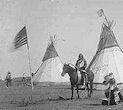
The flag is also used for ceremonial purposes or solemn occasions by the military and other groups. Several Nebraska State Historical images show the American flag at Native American gatherings including “Tipis of chiefs” from 1911. See more ceremonial images.
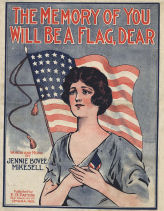
Before “The Star-Spangled Banner” became the U.S. national anthem in 1931, other patriotic songs were also written using our flag as a rallying point to protect “the republic for which it stands”. The musical score, “The Memory of You Will Be a Flag, Dear” from the Polley Music Library collection, is one of several available in Nebraska Memories.
Visit Nebraska Memories to search for or browse through many more historical images digitized from photographs, negatives, postcards, maps, lantern slides, books and other materials.
Nebraska Memories is a cooperative project to digitize Nebraska-related historical and cultural heritage materials and make them available to researchers of all ages via the Internet. Nebraska Memories is brought to you by the Nebraska Library Commission. If your institution is interested in participating in Nebraska Memories, see http://www.nlc.state.ne.us/nebraskamemories/ for more information, or contact Beth Goble, Government Information Services Director, or Devra Dragos, Technology & Access Services Director.
Keystone Pipeline Controversy Heats Up
On the final day for comments the EPA announced that it had filed a comment letter stating that it had placed the project in a category headed “Environmental Objections” and that the Impact Statement is based on insufficient information.
The same day the State Department announced that it plans to host more public meetings within the first 30 days of the 90 day comment period that will follow issuance of the final Environmental Impact Statement. The meetings are intended to give the public an opportunity to voice their views on economic, energy security, environmental and safety issues, and will be held in Montana, South Dakota, Nebraska, Oklahoma,Texas, and Washington D.C. The Department expects to make a decision on whether to grant or deny the permit before the end of 2011.
A print copy of the Supplemental Draft Environmental Impact Statement for the Keystone XL Project is available for loan from the Library Commission. Call number S 1.2: K49/2011 To request a loan contact the
Reference Desk
Wedding Bells
To celebrate the beginning of June, a traditional month for weddings, take a look at some of the images of weddings in Nebraska Memories. The celebrations range from large family gatherings to small wartime ceremonies, and they show how wedding customs have changed over the years.
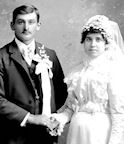
This 1902 portrait of Mr. and Mrs. Emmett Duffek is one of many wedding portraits taken by Harvey Boston, a photographer in David City. William Wentworth, an Omaha photographer, also took many wedding photographs in the 1940s, including this one at the Kelly wedding.

Visit Nebraska Memories to search for or browse through many more historical images digitized from photographs, negatives, postcards, maps, lantern slides, books and other materials.
Nebraska Memories is a cooperative project to digitize Nebraska-related historical and cultural heritage materials and make them available to researchers of all ages via the Internet. Nebraska Memories is brought to you by the Nebraska Library Commission. If your institution is interested in participating in Nebraska Memories, see http://www.nlc.state.ne.us/nebraskamemories/ for more information, or contact Beth Goble, Government Information Services Director, or Devra Dragos, Technology & Access Services Director.
Nebraska Marble
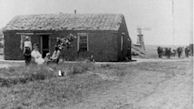
In 1862, the United States Congress passed the Homestead Act, which turned over large amounts of public land to private citizens. Homesteaders were able to claim 160 acres of land and were required to make improvements to the land, which included building a house on it within six months. On the Great Plains, where trees were scarce, many homesteaders built homes out of sod, which was jokingly called “Nebraska marble.” For more information on sod houses, explore these resources from the Smithsonian Institution or NebraskaStudies.org.
The house on the homestead of Herman Staberg is one example of a residence made of sod. Sod was not only used for houses, but for other buildings as well. This school in Cheyenne County and this church in Funk were both made out of sod. 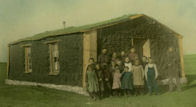
More images of sod buildings can be seen in Nebraska Memories.
Visit Nebraska Memories to search for or browse through many more historical images digitized from photographs, negatives, postcards, maps, lantern slides, books and other materials.
Nebraska Memories is a cooperative project to digitize Nebraska-related historical and cultural heritage materials and make them available to researchers of all ages via the Internet. Nebraska Memories is brought to you by the Nebraska Library Commission. If your institution is interested in participating in Nebraska Memories, see http://www.nlc.state.ne.us/nebraskamemories/ for more information, or contact Beth Goble, Government Information Services Director, or Devra Dragos, Technology & Access Services Director.
Posted in General, Information Resources, Nebraska Memories, Technology
1 Comment
Water Water Everywhere
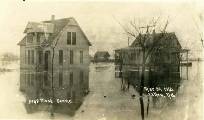
The flooding along the Missouri is worse than it’s been in many years. Water is being released from Lake McConaughy. There seems to be too much water everywhere. Nebraskans have experienced flooding in the past, of course, and some of them were photographed. This photograph of two houses in Valley shows flood waters from the Platte and Elkhorn Rivers that merged in March of 1912 and inundated the town. Flood waters up to four-feet deep left homes full of mud and silthttp://goo.gl/NDSmC
More photographs of the flood in Valley and other floods in Nebraska can be viewed by following this link
http://goo.gl/VZbrr
Visit Nebraska Memories to search for or browse through many more historical images digitized from photographs, negatives, postcards, maps, lantern slides, books and other materials.
Nebraska Memories is a cooperative project to digitize Nebraska-related historical and cultural heritage materials and make them available to researchers of all ages via the Internet. Nebraska Memories is brought to you by the Nebraska Library Commission. If your institution is interested in participating in Nebraska Memories, see http://www.nlc.state.ne.us/nebraskamemories/ for more information, or contact Beth Goble, Government Information Services Director, or Devra Dragos, Technology & Access Services Director.
Posted in General, Information Resources, Nebraska Memories
Leave a comment
Looking for educational software?
Sherston America has agreed to give Nebraska libraries and media centers discounts on a number of their educational programs if ordered through the Nebraska Library Commission. And, if you order by July 31, 2011, you will receive an additional 15% off the discounted price.
Sherston America publishes award-winning, innovative solutions for education. Creative curriculum content, special needs software, science peripherals and evidence-based assessment tools empower teaching and learning, stimulate creativity and equip learners with 21st century technology skills. Their product line fits your environment with products for interactive white boards, traditional classrooms, portable computers and online learning platforms. Titles include award-winning The Big Bus 2.0, Red Pen Tool and the Track Series, as well as BBC Science Simulations and the heralded ReacTickles.
See http://www.nlc.state.ne.us/netserv/pricing/sherston.html for information about available products.
Posted in General, Information Resources
Leave a comment
Flower Garden Inspirations
Spring is here and many folks are busy working in their flower gardens. If you need a bit of inspiration for your garden maybe some photos from the early 1900’s can help.
One source of inspiration is Hanscom Park in Omaha. Hanscom Park was donated to Omaha in 1872 and is one of city’s oldest parks. The 58 acre park is still in existence today and is located in the area of 32nd and Woolworth Ave.  If you have a large yard maybe you want to consider adding a fountain and some flower beds. If that’s not your style how about creating you’re own rose bower or “Lovers lane” as one person noted on a postcard.
If you have a large yard maybe you want to consider adding a fountain and some flower beds. If that’s not your style how about creating you’re own rose bower or “Lovers lane” as one person noted on a postcard.
In addition to the images of the park there are also images of some smaller gardens. The Nye residence in Fremont had a formal garden complete with a gazing ball. The Christensen home, also in Fremont, had two circular flower plantings in the yard. There was even a flower garden in front of South Hall on the Union College campus. If you would rather keep your garden simple you could always take inspiration from J. F. Rosenfield Peony Gardens and just plant twenty-five acres of peonies.
If you are not into gardening and the heat of summer you can always wait for the snow to fly turning Hanscom Park into a winter beauty.
Visit Nebraska Memories to search for or browse through many more historical images digitized from photographs, negatives, postcards, maps, lantern slides, books and other materials.
Nebraska Memories is a cooperative project to digitize Nebraska-related historical and cultural heritage materials and make them available to researchers of all ages via the Internet. Nebraska Memories is brought to you by the Nebraska Library Commission. If your institution is interested in participating in Nebraska Memories, see http://www.nlc.state.ne.us/nebraskamemories/ for more information, or contact Beth Goble, Government Information Services Director, or Devra Dragos, Technology & Access Services Director.
Celebrating Mothers

The practice of honoring mothers has been around for centuries, but Mother’s Day was not an official holiday in the United States until President Woodrow Wilson signed legislation in 1914 establishing the date as the second Sunday in May.
Some people buy cards, flowers, or jewelry to honor their mothers. Others have said it with music, as in this piece, “Sweet Little Mother.” This score and other Mother-related musical materials can be found in the Polley Music Library collection.
 Cherished photographs bring back memories of mothers, grandmothers, great-grandmothers, and more, like this photograph of four generations in Clara Zellinger’s family from the Butler County Gallery collection. Nebraskans must be a hardy bunch as other photographs in Nebraska Memories show multiple generations. Formal and informal photographs of mothers with their children and family groups show a variety of family combinations. And check out the size of some of those families in past years. In comparison, the Census Bureau reports that the average number of births per woman in the United States had dropped to two in 2009.
Cherished photographs bring back memories of mothers, grandmothers, great-grandmothers, and more, like this photograph of four generations in Clara Zellinger’s family from the Butler County Gallery collection. Nebraskans must be a hardy bunch as other photographs in Nebraska Memories show multiple generations. Formal and informal photographs of mothers with their children and family groups show a variety of family combinations. And check out the size of some of those families in past years. In comparison, the Census Bureau reports that the average number of births per woman in the United States had dropped to two in 2009.
Visit Nebraska Memories to search for or browse through many more historical images digitized from photographs, negatives, postcards, maps, lantern slides, books and other materials.
Nebraska Memories is a cooperative project to digitize Nebraska-related historical and cultural heritage materials and make them available to researchers of all ages via the Internet. Nebraska Memories is brought to you by the Nebraska Library Commission. If your institution is interested in participating in Nebraska Memories, see http://www.nlc.state.ne.us/nebraskamemories/ for more information, or contact Beth Goble, Government Information Services Director, or Devra Dragos, Technology & Access Services Director.
Remembering Black Elk

The 29th annual Neihardt Spring Conference will be held at the John G. Neihardt State Historical Site in Bancroft on April 30th, 2011. Many of us have read Black Elk Speaks, the story of the life of the Oglala holy man told to Neihardt in 1931. Black Elk lived through and participated in many of the events spanning the Battle of the Little Big Horn in 1876 to the massacre at Wounded Knee in 1990. He was a cousin to Crazy Horse and knew many Lakota leaders of those times.
This composite image Sitting Bull, Gall, White Bull, Rain in the Face is part of the Nebraska State Historical Society Collection in Nebraska Memories. Photographer John Alvin Anderson was commissioned as a civilian photographer for the U.S. Army to record life on the Rosebud Reservation in South Dakota north of Valentine.
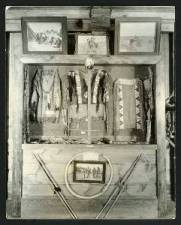 Shirts worn in the battle at Wounded Knee Nebraska State Historical Society Collection, 1890s. This photograph shows three animal hide shirts on display at the Sioux Indian Museum in Rapid City.
Shirts worn in the battle at Wounded Knee Nebraska State Historical Society Collection, 1890s. This photograph shows three animal hide shirts on display at the Sioux Indian Museum in Rapid City.
More photographs of Native Americans can be viewed in Nebraska Memories.
Visit Nebraska Memories to search for or browse through many more historical images digitized from photographs, negatives, postcards, maps, lantern slides, books and other materials.
Nebraska Memories is a cooperative project to digitize Nebraska-related historical and cultural heritage materials and make them available to researchers of all ages via the Internet. Nebraska Memories is brought to you by the Nebraska Library Commission. If your institution is interested in participating in Nebraska Memories, see http://www.nlc.state.ne.us/nebraskamemories/ for more information, or contact Beth Goble, Government Information Services Director, or Devra Dragos, Technology & Access Services Director.
Posted in General, Information Resources, Nebraska Memories
Leave a comment
Re-Shaping Omaha
When Omaha was founded, it looked very different from the city we know today. In the late 1800s and early 1900s, the streets of Omaha underwent a series of re-grading projects that drastically changed the city’s landscape. The level of the streets was lowered in some areas and raised in others. For example, in the late 1800s, at 17th and Farnam, the streets were lowered by 45 feet, and the dirt from this area was used to raise the grade between 20th and 24th Streets. Most buildings in the affected areas were moved to the new street level. Among the reasons for the re-grading, particularly in the later projects, was the need to make it easier for automobiles to navigate the steeply graded streets. In 1917, Dodge Street was re-graded from a 12% to a 7% grade so that cars would be able to more easily reach the top of the hill at 24th and Dodge Streets. (Source: National Register of Historic Places Registration Form for The Logan)
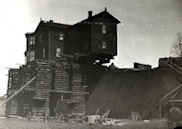
The Falconer residence, located at 1821 Douglas Street, was one of the buildings affected by street re-grading in the late 1800s. This series of photographs shows several images of the movement of the house, including a picture of it settled in its new position. Several other photographs of street re-grading work can be viewed in Nebraska Memories.
Visit Nebraska Memories to search for or browse through many more historical images digitized from photographs, negatives, postcards, maps, lantern slides, books and other materials.
Nebraska Memories is a cooperative project to digitize Nebraska-related historical and cultural heritage materials and make them available to researchers of all ages via the Internet. Nebraska Memories is brought to you by the Nebraska Library Commission. If your institution is interested in participating in Nebraska Memories, see http://www.nlc.state.ne.us/nebraskamemories/ for more information, or contact Beth Goble, Government Information Services Director, or Devra Dragos, Technology & Access Services Director.

